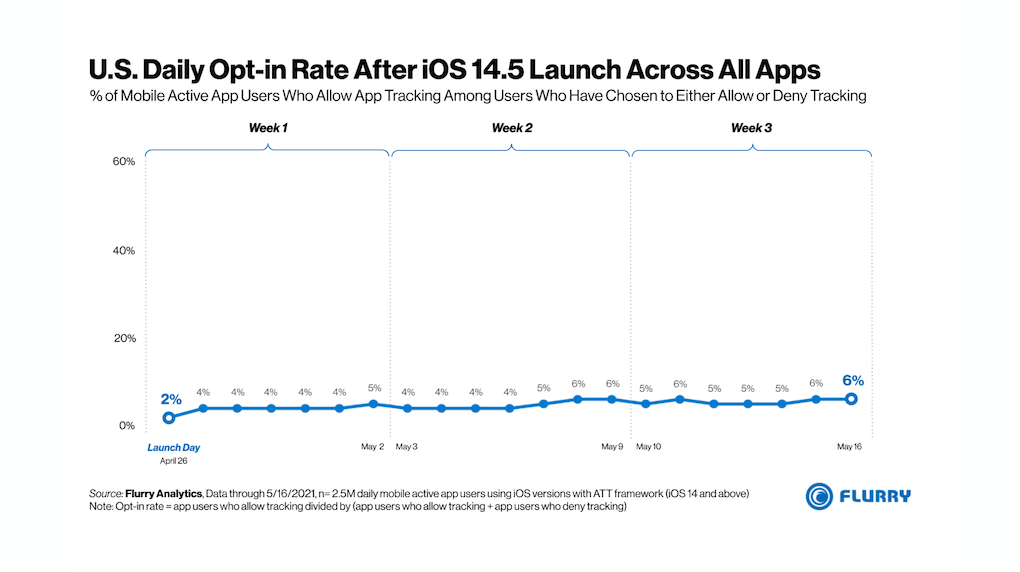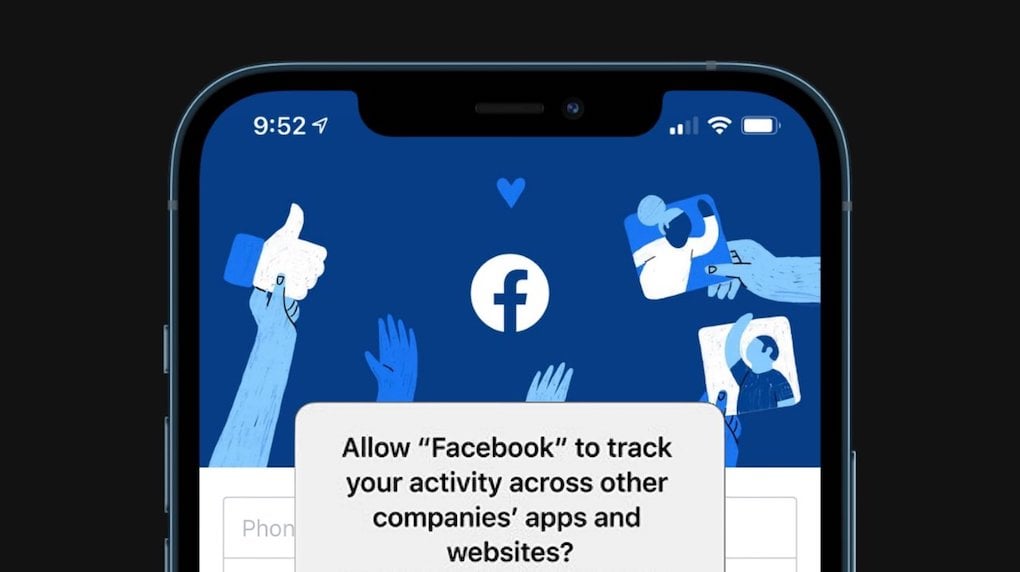For those in the know when it comes to digital marketing, the April debut of Apple iOS 14.5 probably felt a little like the sky was falling.
With the much-anticipated introduction of Apple’s new AppTracking Transparency framework, iOS 14.5 took the major step of requiring all App Store apps to obtain explicit user permission in order to track their data.
Whether you’ve seen the user prompt yourself or witnessed its effects on your campaign performance, it’s easy to see why the change has digital marketers scrambling. But there’s no need to panic — with a proper understanding of the update and the right strategies to adjust, you can still thrive in this new status quo.
How the Apple privacy prompt affects your data
Let’s start with the bad news. With projected opt-in rates for data collection at about 10-15% globally — and actual opt-in rates as low as 6% in the US — iOS 14.5 stands to radically alter the tools available for your digital campaigns.

No opt-in means no access to a user’s Identifier for Advertisers (IDFA), which directly enables key elements of a campaign like targeting, attribution, and optimization. Now only available for a small fraction of Apple device users, it is no longer a reliable tool for marketing at scale.
To fill the gap, advertising platforms have had to overhaul their measurement protocols to comply with the API requirements of Apple’s internal SKAdNetwork, limiting when and how reporting data is available.
For your campaigns, that means results will be restricted, aggregated (rather than user-specific), and delayed (up to 72 hours for web users, and up to 5 days for app users).
The effect on your campaigns — and how to adjust
For a more specific sense of what this means, let’s look at Facebook ads (and Facebook’s Audience Network). It’s no coincidence that Facebook has been one of the most vocal critics of Apple’s new measures —they are potentially the display network most affected by iOS 14.5.

Here are some of the biggest changes and some of the strategies you can use to adjust:
Tracking Limitations
With increasingly strict admin overhead, you’ll need to verify brand domains for each client, and campaign event tracking will be significantly limited on a per-domain basis. That means a hard limit of 8 conversion events tracked on all Pixels associated with a domain.
It's non-negotiable: your campaign objectives and tracking are now limited to those 8 priority events. That means it’s crucial to understand which events are most important to clients’ goals, and approach those with a laser focus.
This is one of the first discussions you should have moving forward, as campaigns with targeting objectives using non-priority events will be paused. Planning which events to prioritize can not only help you avoid these interruptions but also provides an opportunity to level-set with clients. Given the new restrictions, evaluate and redefine what success means on each channel as you move forward.
Attribution issues
The iOS 14.5 changes also restrict cross-domain tracking, which poses a significant challenge for campaign attributions. In particular, it will make it difficult to attribute sales for any clients whose eCommerce storefront isn’t built into the main domain of their website. If possible, offering developer support to make that structural change is more valuable for clients than ever.

The window of time available for attributions has also been sharply reduced, with Facebook moving down from 28 days to just 7.. other ad platforms are likely to follow. This complicates things for businesses with longer or more complex sales funnels and might require high-level strategic adjustment.
Preserve client trust by being upfront about the impact this has on campaign performance, rather than scrambling to justify issues after the fact.
Audience limitations
These restrictions will also mean updating your approach to audience targeting. Without opt-ins, marketers can no longer segment by age, gender, or platform. The sharp decline in tracked users also means significantly smaller custom audiences, limiting your campaigns’ targeting and optimization options.
Other strategic solutions
These limitations may — justifiably — have your clients concerned. To help, there are a few more strategic changes you can suggest as you move forward.
To start, brands’ first-party data has never been more important to their marketing efforts. Help your clients build effective tools for growing internal lists, encouraging subscribers, and ensure they’re getting the right information from customers to start building a robust internal dataset. In place of pixel-based audience lists, you can use these internal customer lists to build lookalike audiences and expand a client’s reach more effectively.

For future campaigns, it may also be worth refocusing on prospecting ads, and traffic/conversion goals that can help refill those depleted audience pools. That means a less personalized approach, making it more important than ever to understand clients’ customer personas and journeys to turn users into customers effectively.
Strong creative will also be more important than ever, as more brands compete for a broader audience, who will be increasingly saturated with this sort of prospecting outreach.
Preparing your campaigns for the future - and iOS 15
That’s not all. iOS 14.5 is just the beginning of Apple’s sweeping changes when it comes to privacy and marketing on their devices.
With the first details of iOS 15 already hinting at further expanded privacy rules that cover email marketing — and a possible launch just in time for the fall holiday window — marketers can’t waste time reminiscing about the options that used to be available.
Stay tuned for more info on those iOS 15 implications, and subscribe to our Mercury blog to hear about it as it happens.